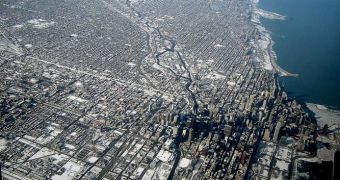Many studies have demonstrated over the past few years that cities tend to be hotter than their surrounding landscape, with the temperature difference situated at around two or three degrees Celsius. This is what is generally referred to as the urban heat island effect, as cities resemble hot spots when viewed from satellites in infrared wavelengths. Mitigating this phenomenon is tremendously important, especially when considering that more heat traps pollution at low altitudes, posing a great danger to people breathing the toxic air. Now, a scientist at the Arizona State University (ASU) proposes new methods of protecting large cities against excessive heat.
According to ASU Architecture Professor Harvey Bryan, the desired effect could be obtained by employing canopies, adding additives to construction materials, or by making smarter use of landscaping techniques. The expert included other methods as well in a presentation called “Digital Simulations and Zoning Codes: To Mitigate Urban Heat Island” that he made recently in San Diego, at the annual meeting of the American Association for the Advancement of Science (AAAS). He explained that cities located in arid areas, or in deserts, were especially vulnerable to the UHI effect.
But all cities experienced this phenomenon, he added. Building materials such as concrete, pavement, and the buildings themselves capture a lot of heat and maintain it at street level. The radiation is then slowly released during the night, as the atmosphere cools, but the same cycle picks up the next day. “Canopies to shade streets and sidewalks keep the concrete and asphalt cooler. Interestingly, sidewalks in downtown Phoenix during the early 1900s were canopied,” Bryan said during his presentation. He added that any form of shade was very beneficial to reducing the UHI effect. In the United States, cities such as Phoenix, Arizona, (average nighttime temperatures of 90 degrees Fahrenheit) could stand most to gain by employing defense methods against heat.
“Introducing additives, like crumb rubber to asphalt and concrete, are ways of reducing heat capacity at the surface and making for a better nighttime profile. The important part is to look at materials performance more than just during the daytime. We need a 24-hour profile to see how materials absorb heat during the day and how they emit it during the evening. We then look for materials that are reflective during the day and highly emitting during the evening. It comes down to how we model the downtown and how we look at various scenarios with different materials using models that accurately simulate the radiative phenomena. Most cities have never used such powerful tools to find solutions to UHI,” the expert concluded.

 14 DAY TRIAL //
14 DAY TRIAL //